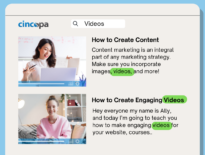YouTube is the second most popular search engine. The website averages more than two billion monthly users. It also happens to be the second most popular search engine on the planet, which means YouTube SEO is critical if you want to grow your channel and reach a wider audience.
A cornerstone of YouTube is the analytics dashboard. YouTube analytics enable you to identify the things you are doing right with your marketing and where you have problems. This guide will walk you through the eight critical YouTube analytics metrics that you need to monitor.
1. Watch Time
A lot of marketers and channel owners use view count as a success metric for videos. However, view count by itself doesn’t say much and has nominal weightage in YouTube’s algorithm. The simple reason is that view counts are easy to game with clickbait tactics.
From YouTube’s perspective (and yours), a more important factor to monitor is the watch time. Your watch time is the total time people spent watching your video.

Source: ConstantContactBlog
The updated YouTube analytics dashboard devotes an entire section to watch time. You can drill down your analysis based on variables like video theme, length, and styles.
If your videos have a good view count but low watch times, the issues could be content-centric (not engaging enough for your audience) or production-centric (cameras, editing software). Whatever the issue, it’s a problem you’ll need to fix. That means reviewing the way you come up with ideas for content, how you present the content, and ultimately how you produce the content.
Channels with high watch-time videos are more likely to rank higher in the search results. If you can make your content trend on YouTube or rank highly in the search results, you’re well on your way to growing your business.
There are some complimentary marketing strategies you can use to improve overall watch time. Most of these revolve around growing your core audience. For example, live streaming is a great way to build engagement with your core audience. You can also run retargeting campaigns to engage people who have watched your videos in the past.
2. Identify your traffic source
Identifying your traffic sources allows you to analyze the reach of your videos. It tells you where your viewers are based and the referral source. YouTube analytics allow you to analyze the source based on the geographical location of the viewer:

Source: YouTube
You can also monitor the referring source for the viewers:

Source: FanBridge
These reports enable you to identify your best sources of traffic. Understanding where your visitors are coming from will help your marketing efforts.
Don’t just analyze referral traffic by volume. The quality of traffic, average view time is equally important.
For instance, if your video is attracting high-quality traffic via YouTube search, that is where you should focus your marketing efforts. Likewise, sources that are referring high-quality traffic in low volumes could be a growth opportunity.
It’s good to think out of the box as well. New website design trends can offer opportunities to engage visitors and funnel them to your videos.
3. Track your audience demographics
Segmenting and targeting your audience are the basics of all marketing strategies. Targeted ads are twice as effective in yielding conversions when compared to non-targeted ads. Knowing your audience’s profile and creating content relevant to this audience will yield higher engagement with your videos.
In the words of Seth Godin, a leading marketing expert, “Don’t find customers for your products, find products for your customers.”

Source: singlegrain
Combining audience demographic metrics with geographical source data allows you to build a consumer persona across global markets. You can then create content that fits the interests and needs of your customers.
Your YouTube channel gives your e-commerce product videos an extended reach beyond normal search engines. The age, gender, and location of your audience give you insights into creating professional product videos.
4. Track your impressions and click-through rates
An impression is your video thumbnail showing up on a user’s screen. Analyze the data on your thumbnail to identify the keywords that trigger the YouTube algorithm to push and distribute your video to the user’s screen. You can also analyze the formats that yield the highest and lowest impression reach.
The impression Click Through Rate (CTR) gives the conversion percentage from impressions to views. It tells you how many of the people clicked on the video after seeing your thumbnail.
YouTube analytics converts these two metrics to a conversion funnel for better analysis.

Source: SproutSocial
Analyzing the metrics on the funnel gives you an accurate analysis of your video.
A high CTR is great and indicates your title and thumbnail text are doing a great job attracting viewers. However, a high CTR coupled with a low watch time means you have content-centric issues. Focus on creating more compelling and engaging content.
5. Monitor subscriber growth
Building your subscriber base extends the reach of your content. You want a large and growing subscriber base. Subscriber growth is a key metric used by the YouTube algorithm for pushing video recommendations.

Source: backlinko
One way to build your subscriber base is to cross-promote your YouTube channel through your organic marketing strategies like email marketing. Subscriber growth is a vital YouTube analytics metric. You should monitor subscriber growth and use the insights to form strategic marketing objectives for your campaigns.
6. Analyze audience retention
Like watch time, audience retention is a qualitative measure of your video’s views. Audience retention measures your video to view count for your videos. The audience retention page has two tabs for absolute retention and relative retention.
Absolute retention measures the viewing pattern of a specific video. The graph shows the parts of your video that are most popular and the points of major disengagement. It also allows you to understand viewer behavior, like skipping the introduction portion of your video.
Relative retention measures the viewing pattern of your video versus all other videos on YouTube of similar length. It helps you evaluate viewer engagement against a broad average for videos of a similar length.

Source: Moz
Open the retention page and play your video. The red bar moves and allows you to pause it at the exact point where the viewership drops. Evaluate the content at this point to identify what triggers the negative viewer response. For instance, in the graph above, the disengagement point is around the 1:33 mark.
Analyzing viewer retention enables you to identify problems. One limitation of the audience retention page is that you can only evaluate one video at a time. You can’t evaluate your channel as a whole.
7. Track your social shares
Social shares are one of the forces behind Youtube videos going viral, so monitoring this metric is a crucial element to the success of a video marketing strategy. Social media can play a big role in spreading the reach of your videos. Hence, it’s important to know how your videos are being shared. How many viewers are sharing and the platforms where they are sharing your content.
Click on the sharing page in YouTube Analytics, and you will get a snapshot of the number of shares across the social platforms and platforms like text messaging, WhatsApp, and email. Use these metrics to identify social platforms where you should be sharing your videos to boost their reach and conversion.
8. Monitor likes, dislikes, and comments
Likes and dislikes provide instant feedback for your video. All videos will have a certain number of dislikes. You can’t make everyone happy all the time. What is important is the ratio between likes and dislikes. If 80% of the viewers liked your video and 20% didn’t, you’re doing good.
If one of your videos receives a disproportionate number lot of dislikes, start by asking yourself the following questions:
- Are the title and thumbnail on-point with the content?
- Is the content relevant to my target audience?
- Does the video have production-centric issues like sound and picture quality? A possible solution would be to create your video on professional video creation platforms.
- Is the content of the video offensive?
Finally, you have comments. Comments are an excellent avenue for building audience engagement.

Source: Position2
Engaging with and responding to comments will help you create an engaged audience. Click on the Comments tab on the Analytics page to see the frequency and dates of your comments.
Look for opportunities to:
- Provide insights or a useful remark.
- Highlight your products and services.
- Direct viewers to related content on your channel.
By actively responding to comments, you project your brand as an approachable and engaging one.
Wrapping Up
Youtube Analytics enables you to track several metrics that measure your content’s reach and the level of audience engagement with your content. Metrics like watch time, retention, engagement, click-through rates, and demographics help you evaluate the success of your video marketing strategy.
This guide walked you through eight of the most important YouTube analytics metrics. By monitoring these metrics, you’ll gain insights that will help you grow your channel. That’s important because Youtube is a great platform to create brand awareness while offering valuable, engaging, and solution-centric content to your audience.









